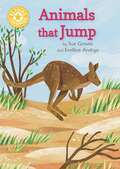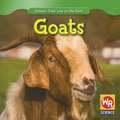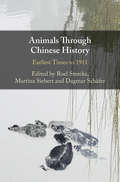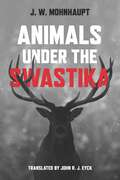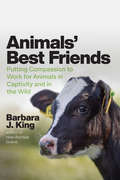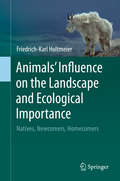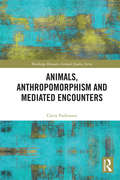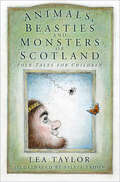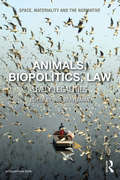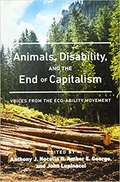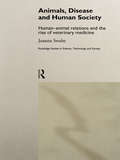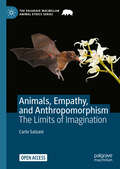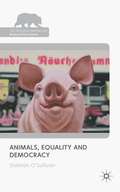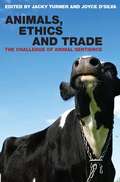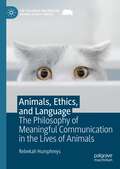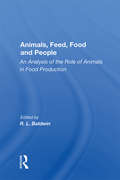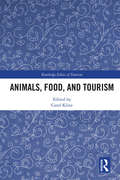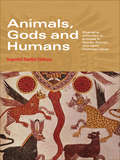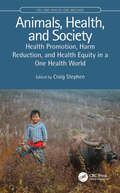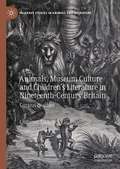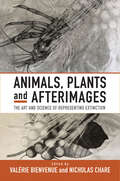- Table View
- List View
Animals that Jump: Independent Reading Yellow 3 Non-fiction (Reading Champion #515)
by Sue GravesThis non-fiction book about animal that jump, from frogs to kangaroos, is part of Reading Champion, a series carefully linked to book bands to encourage independent reading skills, developed with Dr Sue Bodman and Glen Franklin of UCL Institute of Education (IOE)Reading Champion offers independent reading books for children to practise and reinforce their developing reading skills.Fantastic, original stories are accompanied by engaging artwork and a reading activity. Each book has been carefully graded so that it can be matched to a child's reading ability, encouraging reading for pleasure. Perfect for children aged 4-5 or reading at book band yellow 3.
Animals that Live on the Farm: Goats
by Joann Early MackenLearn about the characteristics and behavior of goats.
Animals through Chinese History: Earliest Times to 1911
by Roel Sterckx Dagmar Schäfer Martina SiebertThis volume opens a door into the rich history of animals in China. As environmental historians turn their attention to expanded chronologies of natural change, something new can be said about human history through animals and about the globally diverse cultural and historical dynamics that have led to perceptions of animals as wild or cultures as civilized. This innovative collection of essays spanning Chinese history reveals how relations between past and present, lived and literary reality, have been central to how information about animals and the natural world has been processed and evaluated in China. Drawing on an extensive array of primary sources, ranging from ritual texts to poetry to veterinary science, this volume explores developments in the human-animal relationship through Chinese history and the ways in which the Chinese have thought about the world with and through animals. This title is also available as Open Access.
Animals under the Swastika
by Jan Wolf MohnhauptNever before or since have animals played as significant a role in German history as they did during the Third Reich. Potato beetles and silkworms were used as weapons of war, pigs were used in propaganda, and dog breeding served the Nazis as a model for their racial theories. Paradoxically, some animals were put under special protection while some humans were simultaneously declared unworthy of living. Ultimately, the ways in which Nazis conceptualized and used animals—both literally and symbolically—reveals much about their racist and bigoted attitudes toward other humans. Drawing from diaries, journals, school textbooks, and printed propaganda, J.W. Mohnhaupt tells these animals’ stories vividly and with an eye for everyday detail, focusing each chapter on a different facet of Nazism by way of a specific animal species: red deer, horses, cats, and more. Animals under the Swastika illustrates the complicated, thought-provoking relationship between Nazis and animals.
Animals under the Swastika
by Jan Wolf MohnhauptNever before or since have animals played as significant a role in German history as they did during the Third Reich. Potato beetles and silkworms were used as weapons of war, pigs were used in propaganda, and dog breeding served the Nazis as a model for their racial theories. Paradoxically, some animals were put under special protection while some humans were simultaneously declared unworthy of living. Ultimately, the ways in which Nazis conceptualized and used animals—both literally and symbolically—reveals much about their racist and bigoted attitudes toward other humans. Drawing from diaries, journals, school textbooks, and printed propaganda, J.W. Mohnhaupt tells these animals’ stories vividly and with an eye for everyday detail, focusing each chapter on a different facet of Nazism by way of a specific animal species: red deer, horses, cats, and more. Animals under the Swastika illustrates the complicated, thought-provoking relationship between Nazis and animals.
Animals with Armor (Into Reading, Level O #57)
by Jill McDougallNIMAC-sourced textbook <p><p> Many animals have armor to protect them. Armor makes it very hard for a predator to eat its prey. Find out about the different kinds of armor: spikes, scales, shells, and exoskeletons.
Animals' Best Friends: Putting Compassion to Work for Animals in Captivity and in the Wild
by Barbara J. King“King’s Animals’ Best Friends is the most comprehensive exploration I’ve read of the complex relationship between the human and nonhuman, full of great insights and practical information.”—Jeff VanderMeer, New York Times Book Review, “By the Book”Finalist for the 2021 Siskiyou Prize for New Environmental Literature As people come to understand more about animals’ inner lives—the intricacies of their thoughts and the emotions that are expressed every day by whales and cows, octopus and mice, even bees—we feel a growing compassion, a desire to better their lives. But how do we translate this compassion into helping other creatures, both those that are and are not our pets? Bringing together the latest science with heartfelt storytelling, Animals’ Best Friends reveals the opportunities we have in everyday life to help animals in our homes, in the wild, in zoos, and in science labs, as well as those considered to be food. Barbara J. King, an expert on animal cognition and emotion, guides us on a journey both animal and deeply human. We meet cows living relaxed lives in an animal sanctuary—and cows with plastic portals in their sides at a university research station. We observe bison free-roaming at Yellowstone National Park and chimpanzees confined to zoos. We learn with King how to negotiate vegetarian preferences in omnivore restaurants. We experience the touch of a giant Pacific octopus tasting King’s skin with one of his long, neuron-rich arms. We reflect on animal testing as King shares her own experience as the survivor of a particularly nasty cancer. And in a moment all too familiar to many of us, we recover from a close encounter with two spiders in the home. This is a book not of shaming and limitation, but of uplift and expansion. Throughout this journey, King makes no claims of personal perfection. Though an animal expert, she is just like the rest of us: on a journey still, learning each day how to be better, and do better, for animals. But as Animals’ Best Friends makes clear, challenging choices can bring deep rewards. By turning compassion into action on behalf of animals, we not only improve animals’ lives—we also immeasurably enrich our own.
Animals' Influence on the Landscape and Ecological Importance: Natives, Newcomers, Homecomers
by Friedrich-Karl HoltmeierIn its first English-language edition, this book introduces the many-faceted interactions of animal populations with their habitats. From soil fauna, ants and termites to small and large herbivores, burrowing mammals and birds, the author presents a comprehensive analysis of animals and ecosystems that is as broad and varied as all nature. Chapter 2 addresses the functional role of animals in landscape ecosystems, emphasizing fluxes of energy and matter within and between ecosystems, and the effects of animals on qualitative and structural habitat change. Discussion includes chapters on the role of animal population density and the impacts of native herbivores on vegetation and habitats from the tropics to the polar regions. Cyclic mass outbreaks of species such as the larch bud moth in Switzerland, the mountain pine beetle and the African red-billed weaver bird are described and analyzed. Other chapters discuss Zoochory - the dispersal of seeds by ants, mammals and birds - and the influence of burrowing animals on soil development and geomorphology. Consideration extends to the impact of feral domestic animals. Chapter 5 focuses on problems resulting from introduction of alien animals and from re-introduction of animal species to their original habitats, discusses the effects on ecosystems of burrowing, digging and trampling by animals. The author also addresses keystone species such as kangaroo rats, termites and beavers. Chapter 6 addresses the role of animals in landscape management and nature conservation, with chapters on the impact of newcomer species such as animals introduced into Australia, New Zealand and Europe, and the consequences of reintroduction of species to original habitat. It also discusses the carrying capacity of natural habit, public attitudes toward conversation and more. The final section ponders the effects of climate on interactions between animals and their habitats.
Animals, Anthropomorphism and Mediated Encounters (Routledge Human-Animal Studies Series)
by Claire ParkinsonThis book critically investigates the pervasiveness of anthropomorphised animals in popular culture. Anthropomorphism in popular visual media has long been denounced for being unsophisticated or emotionally manipulative. It is often criticised for over-expressing similarities between humans and other animals. This book focuses on everyday encounters with visual representations of anthropomorphised animals and considers how attributing other animals with humanlike qualities speaks to a complex set of power relations. Through a series of case studies, it explores how anthropomorphism is produced and circulated and proposes that it can serve to create both misunderstandings and empathetic connections between humans and other animals. This book will appeal to academics and students interested in visual media, animal studies, sociology and cultural studies.
Animals, Beasties and Monsters of Scotland: Folk Tales for Children
by Lea Taylor Sylvia TroonWhat do you think happened when Jack refused to do his chores? Do you think you’re clever enough to hide from Dundee’s dragon? Watch out for Lefty the spider dying to tell you his story about life in the glen … The stories in this book are of animals, beasties and monsters that are fast and cunning and scary and big. And they are ready to tell their tales to you …
Animals, Biopolitics, Law: Lively Legalities
by Irus BravermanTypically, the legal investigation of nonhuman life, and of animal life in particular, is conducted through the discourse of animal rights. Within this discourse, legal rights are extended to certain nonhuman animals through the same liberal framework that has afforded human rights before it. Animals, Biopolitics, Law envisions the possibility of lively legalities that move beyond the humanist perspective. Drawing on an array of expertise—from law, geography, and anthropology, through animal studies and posthumanism, to science and technology studies—this interdisciplinary collection asks what, in legal terms, it means to be human and nonhuman, what it means to govern and to be governed, and what are the ethical and political concerns that emerge in the project of governing not only human but also more-than-human life.
Animals, Disability, and the End of Capitalism: Voices from the Eco-Ability Movement (Radical Animal Studies and Total Liberation #1)
by John Lupinacci Anthony J. Nocella Amber E. George<p>Animals, Disability, and the End of Capitalism is a collection of essays from the leaders in the field of eco-ability. The book is rooted in critical pedagogy, inclusive education, and environmental education. The efforts of diverse disability activists work to weave together the complex diversity and vastly overlooked interconnections among nature, ability, and animals. Eco-ability challenges social constructions, binaries, domination, and normalcy. Contributors challenge the concepts of disability, animal, and nature in relation to human and man. Eco-ability stresses the interdependent relationship among everything and how the effect of one action such as the extinction of a species in Africa can affect the ecosystem in Northern California. Animals, Disability, and the End of Capitalism is timely and offers important critical insight from within the growing movement and the current academic climate for such scholarship. The book also provides insights and examples of radical experiences, pedagogical projects, and perspectives shaped by critical animal studies, critical environmental studies, and critical disability studies. <p>Contributors include Sarah R. Adams, Marissa Anderson, Judy K. C. Bentley, Mary Fantaske, Amber E. George, Ava HaberkornHalm, John Lupinacci, Hannah Monroe, Anthony J. Nocella II, Nicole R. Pallotta, Meneka Repka, and Daniel Salomon.</p>
Animals, Disease and Human Society: Human-animal Relations and the Rise of Veterinary Medicine (Routledge Studies in Science, Technology and Society #No.2)
by Joanna SwabeThis book explores the history and nature of our dependency on other animals and the implications of this for human and animal health. Writing from an historical and sociological perspective, Joanna Swabe's work discusses such issues as:* animal domestication* the consequences of human exploitation of other animals, including links between human and animal disease* the rise of a veterinary regime, designed to protect humans and animals alike* implications of intensive farming practices, pet-keeping and recent biotechnological developments.This account spans a period of some ten thousand years, and raises important questions about the increasing intensification of animal use for both animal and human health.
Animals, Empathy, and Anthropomorphism: The Limits of Imagination (The Palgrave Macmillan Animal Ethics Series)
by Carlo SalzaniThis open access book explores the role of imagination in animal ethics and its constitutive links to empathy/sympathy and anthropomorphism. The book argues for the constitutive role of imagination in ethical deliberation, but acknowledges that there exist important limits to its use. However, &“limit&” is here understood not merely negatively as restriction and insufficiency, but rather positively as &“condition of possibility,&” so what the book explores and analyses are the conditions for a positive and fruitful use of the imagination in ethics. The book uses as a &“frame&” the questions and issues raised in J.M. Coetzee&’s The Lives of Animals to explore some central and salient themes.
Animals, Equality and Democracy (The Palgrave Macmillan Animal Ethics)
by Siobhan O’SullivanAnimals, Equality and Democracy examines the structure of animal protection legislation and finds that it is deeply inequitable, with a tendency to favour those animals the community is most likely to see and engage with. Siobhan O'Sullivan argues that these inequities violate fundamental principle of justice and transparency.
Animals, Ethics and Trade: The Challenge of Animal Sentience
by Joyce D'Silva Jacky TurnerModern urban life cuts us off from direct connection with the animal world, yet daily the lives of millions of animals are affected by what we consume and wear and what we trade in. The use of animals for food, labour and pleasure pursuits has long been justified with the assumption that unlike humans, animals aren't fully sentient beings. In recent years, however, science has revealed an astonishing array of complex animal behaviour, and scientists and policy makers now accept that the animals we make use of are indeed conscious, with preferences and intentions. The implications for our culture of factory farming, fast food and rainforest liquidation are staggering. In this powerful book, internationally renowned experts on animal behaviour and agriculture such as Jane Goodall, Tim Lang and Vandana Shiva are brought together with ethicists, religious scholars, international industry and regulators for the first time to debate these critical issues and tackle the profound implications of animal sentience. ? The first sections discuss scientific and ethical perspectives on the consciousness, emotions and mental abilities of animals. Later sections address how human activities such as science, law, religion, farming, food production, trade, development and education respect or ignore animals' sentience and welfare, and review the options for changes in our policies, our practices and our thinking. The result is nothing less than a stark and necessary look into the heart of humanity and the ethics that govern our animal powered society.
Animals, Ethics, and Language: The Philosophy of Meaningful Communication in the Lives of Animals (The Palgrave Macmillan Animal Ethics Series)
by Rebekah HumphreysWith an ever-growing body of evidence on the links between different oppressions, never have the debates in Critical Animal Studies surrounding intersectionality in relation to animal ethics been more important. In particular, the arguments related to anthropomorphic attributes of mentality to other than humans promise to provide fruitful new ground for re-assessing human-animal relations. This book maps the central debates surrounding anthropomorphism in relation to our descriptions of animals, their lives, animal mentality, and meaningful communication in the nonhuman world. Rebekah Humphreys synthesizes the work of critical animal theorists, philosophers, and cognitive ethologists, and provides a critical account of how the debates concerning anthropomorphism play a key role in a proper understanding of animal ethics.
Animals, Feed, Food And People: An Analysis Of The Role Of Animals In Food Production
by R. L. BaldwinNumerous authors have presented analyses of the world food problem and the appropriate role of animals in food production and have drawn qualitative conclusions. However, projection and planning require quantitative considerations, and this volume addresses that challenge. Experts in animal science, farm management, economics, international agriculture, and nutrition elucidate and debate germane issues with scientific rigor. They examine the efficiency and economics of animal production, feed resource availability, interactions between plant and animal agricultures, international trade, resource allocation, roles of animals in developing countries, and the nutritional values and limitations of animal products.
Animals, Food, and Tourism (Routledge Research in the Ethics of Tourism Series)
by Carol KlineFood is routinely given attention in tourism research as a motivator of travel. Regardless of whether tourists travel with a primary motivation for experiencing local food, eating is required during their trip. This book encompasses an interdisciplinary discussion of animals as a source of food within the context of tourism. Themes include the raising, harvesting, and processing of farm animals for food; considerations in marketing animals as food; and the link between consuming animals and current environmental concerns. Ethical issues are addressed in social, economic, environmental, and political terms. The chapters are grounded in ethics-related theories and frameworks including critical theory, ecofeminism, gustatory ethics, environmental ethics, ethics within a political economy context, cultural relativism, market construction paradigm, ethical resistance, and the Global Sustainable Tourism Criteria. Several chapters explore contradicting and paradoxical ethical perspectives, whether those contradictions exist between government and private sector, between tourism and other industries, or whether they lie within ourselves. Like the authors in Tourism Experiences & Animal Consumption: Contested Values, Morality, & Ethics, the authors in this book wrestle with a range of issues such as animal sentience, the environmental consequences of animals as food, viewing animals solely as a extractive resource for human will, as well as the artificial cultural distortion of animals as food for tourism marketing purposes. This book will appeal to tourism academics and graduate students as a reference for their own research or as supplementary material for courses focused on ethics within tourism.
Animals, Gods and Humans: Changing Attitudes to Animals in Greek, Roman and Early Christian Thought
by Ingvild Saelid GilhusConsulting a wide range of key texts and source material, Animals, Gods and Humans covers 800 years and provides a detailed analysis of early Christian attitudes to, and the position of, animals in Greek and Roman life and thought. Both the pagan and Christian conceptions of animals are rich and multilayered, and Ingvild Sælid Gilhus expertly examines the dominant themes and developments in the conception of animals. Including study of: biographies of figures such as Apollonus of Tyana; natural history; the New Testament via Gnostic texts; the church fathers; and from pagan and Christian criticism of animal sacrifice, to the acts of martyrs, the source material and detailed analysis included in this volume make it a veritable feast of information for all classicists.
Animals, Health, and Society: Health Promotion, Harm Reduction, and Health Equity in a One Health World (CRC One Health One Welfare)
by Craig StephenThis timely book reframes the historic narrative of people, animals, and nature as risks to each other, to one where we think about health as a shared capacity. This new narrative promotes the positive contributions made to health across species and generations and addresses growing calls to shift from a reactive to proactive approach in One Health. Editor Craig Stephen takes the reader on a tour of the situations wherein we can all, regardless of our job description, work across species, sectors, and generations to motivate action. Perspectives and methods from a variety of fields and experts are shared and adapted to promote collaborative understanding of and action on determinants of health at the animal-society interface. Case studies demonstrate that the principles and practices presented are feasible, empowering people to make choices that concurrently benefit the health of animals, societies, and ecosystems. The first book to adapt and explain health promotion, harm reduction, and health equity issues in a One Health context, and in terms of animal health, this is necessary reading for students of and practitioners working in planetary health, conservation, ecohealth, public health, health promotion, veterinary medicine, and animal welfare.
Animals, Museum Culture and Children’s Literature in Nineteenth-Century Britain: Curious Beasties (Palgrave Studies in Animals and Literature)
by Laurence TalairachAnimals, Museum Culture and Children’s Literature in Nineteenth-Century Britain: Curious Beasties explores the relationship between the zoological and palaeontological specimens brought back from around the world in the long nineteenth century—be they alive, stuffed or fossilised—and the development of children’s literature at this time. Children’s literature emerged as dizzying numbers of new species flooded into Britain with scientific expeditions, from giraffes and hippopotami to kangaroos, wombats, platypuses or sloths. As the book argues, late Georgian, Victorian and Edwardian children’s writers took part in the urge for mass education and presented the world and its curious creatures to children, often borrowing from their museum culture and its objects to map out that world. This original exploration illuminates how children’s literature dealt with the new ordering of the world, offering a unique viewpoint on the construction of science in the long nineteenth century.
Animals, Plants and Afterimages: The Art and Science of Representing Extinction
by Nicholas Chare Valérie BienvenueThe sixth mass extinction or Anthropocene extinction is one of the most pervasive issues of our time. Animals, Plants and Afterimages brings together leading scholars in the humanities and life sciences to explore how extinct species are represented in art and visual culture, with a special emphasis on museums. Engaging with celebrated cases of vanished species such as the quagga and the thylacine as well as less well-known examples of animals and plants, these essays explore how representations of recent and ancient extinctions help advance scientific understanding and speak to contemporary ecological and environmental concerns.
